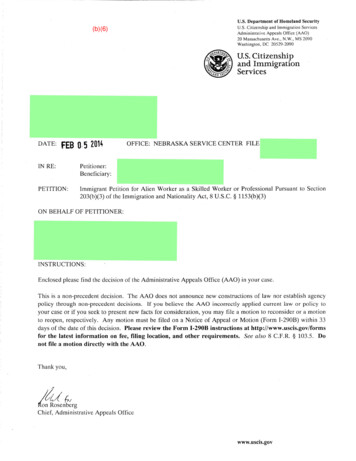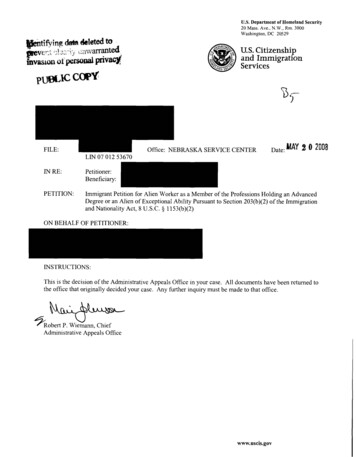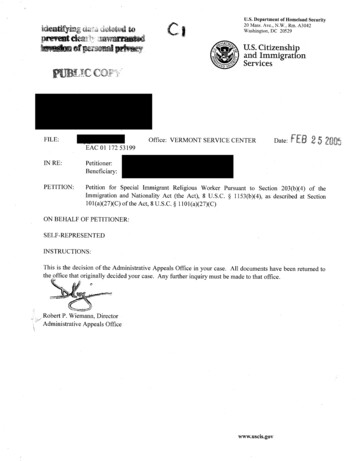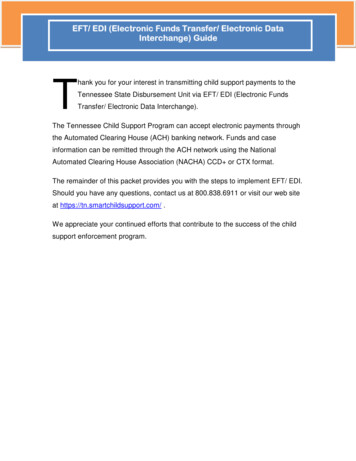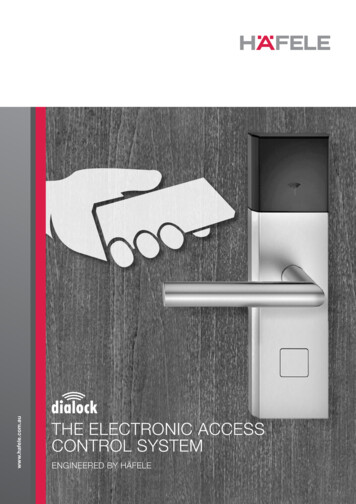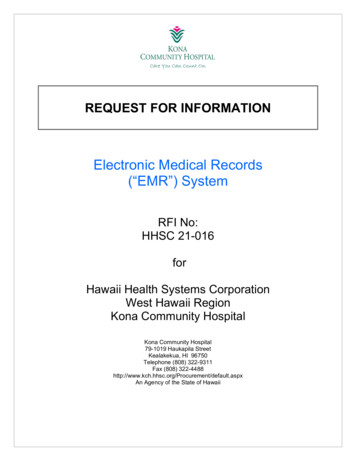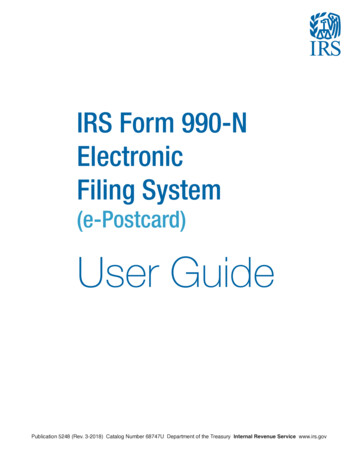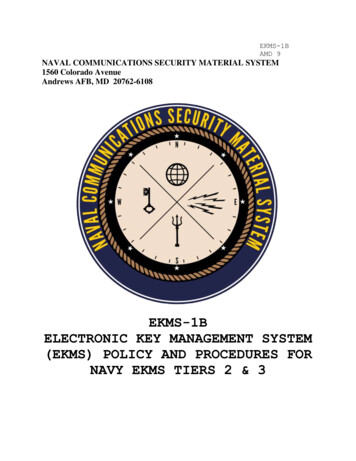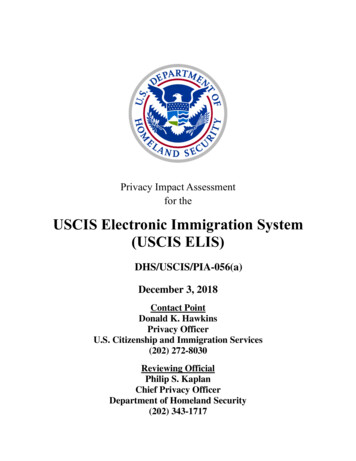
Transcription
Privacy Impact Assessmentfor theUSCIS Electronic Immigration System(USCIS ELIS)DHS/USCIS/PIA-056(a)December 3, 2018Contact PointDonald K. HawkinsPrivacy OfficerU.S. Citizenship and Immigration Services(202) 272-8030Reviewing OfficialPhilip S. KaplanChief Privacy OfficerDepartment of Homeland Security(202) 343-1717
Privacy Impact AssessmentDHS/USCIS/PIA-056(a) USCIS ELISPage 1AbstractU.S. Citizenship and Immigration Services (USCIS) operates the USCIS ElectronicImmigration System (USCIS ELIS). USCIS ELIS was originally developed to serve as a publicfacing electronic filing system supporting the submission of benefit request forms. USCIS ELISalso served as the internal case management system for USCIS adjudicators to efficiently processbenefit request forms. USCIS ELIS was recently redesigned to exclusively serve as an internalelectronic case management system for electronically filed benefit request forms and certain paperforms. MyUSCIS Account Experience replaced all aspects of the public-facing USCIS ELIS.1USCIS is updating and reissuing the USCIS ELIS PIA to discuss the shift from supporting thepublic-facing electronic filing system to serving solely as an internal case management systemwith new functionalities and system interconnections. This PIA replaces the previously issuedDHS/USCIS/PIA-056 published on May 17, 2016. As USCIS ELIS adds other forms and services,USCIS will update this PIA and its appendices accordingly.OverviewUSCIS is the component within the Department of Homeland Security (DHS) that overseeslawful immigration to the United States. In part, the USCIS mission is to provide accurateinformation while ensuring the integrity of the U.S. immigration system and adjudicating requestsefficiently and fairly. USCIS receives applications, petitions, and other benefit requests(collectively referred to as benefit request forms) from individuals seeking immigration and nonimmigration benefits. USCIS has historically received paper-based applications for adjudicationand relied on a complex paper-based process to execute the immigration and naturalizationmission.USCIS is continuing the current paper-based operations and also steadily transforming toan electronic, online environment to improve operational efficiency, and improve customerengagement. Currently, most benefit request forms, including all supporting evidence, are stillsubmitted in paper format by applicants, petitioners, or requestors (collectively referred to asbenefit requestors), or their legal representatives. In turn, USCIS communicates case informationand issues paper notices to benefit requestors and legal representatives.USCIS offers an alternate filing method, online filing, to improve the way benefitrequestors and legal representatives apply for and manage immigration benefit requests by shiftingthe process from a paper-based system to a secure online case management system. The MyUSCISAccount Experience offers a personalized, online account for benefit requestors and legal1See DHS/USCIS/PIA-071 MyUSCIS Account Experience, available at www.dhs.gov/privacy.
Privacy Impact AssessmentDHS/USCIS/PIA-056(a) USCIS ELISPage 2representatives to electronically file benefit request forms, and replaces all aspects of the publicfacing electronic filing component previously available through USCIS ELIS.Since the MyUSCIS Account Experience is now the public-facing online filing component,USCIS ELIS serves as the primary internal case management system for both electronically filedand paper-based benefit request forms. USCIS ELIS creates person-centric accounts for eachbenefit requestor. USCIS will continue to expand available immigration product lines withinUSCIS ELIS to support the agency’s modernization initiative of receiving and processing formsin an electronic environment.Application InitiationAs described in the Benefit Request and Intake PIA, to begin the benefit request process,the benefit requestor must complete a USCIS benefit request form.2 Individuals have the option tocomplete the benefit request form either by paper or, if available, electronically, through an onlineaccount. Both methods collect the same information and fees. Upon completion, individualssubmit the benefit request form, required supporting documents and filing fee payment, or feewaiver request, as appropriate. Individuals submit benefit request forms according to the forminstructions. USCIS ELIS receives paper forms through the USCIS Lockbox facilities3 orelectronically from a system interconnection with MyUSCIS.4Paper FilingsUSCIS requires benefit requestors to submit paper benefit request forms to a specifiedLockbox facility. U.S. Lockbox facilities are operated by the U.S. Department of Treasury(Treasury) and are staffed by financial agents working on behalf of USCIS to receive paperrequests, process payments, and forward the immigration requests as directed by USCIS for furtherprocessing. This contractor manages the intake of paper USCIS benefit request forms and thecollection of associated fees submitted by mail. The Lockbox operates the mechanisms to convertthe submitted information into an electronic format, deposit associated filing fees, generate areceipt or rejection notices to applicants, and transmit the benefit request information to the USCISELIS system. The contractor does not approve or deny benefit request forms received by theUSCIS Lockbox. The Lockbox scans an image of the benefit request form and supportingdocumentation into an electronic format and sends it to USCIS ELIS for ingestion. Depending onthe form type, after the form is ingested into USCIS ELIS, the paper copy may be destroyed.2See DHS/USCIS/PIA-061 Benefit Request and Intake Process, available at www.dhs.gov/privacy.The USCIS Lockbox serves as a collection receptacle for the intake of forms and processing of fees forimmigration benefit request forms. For more information, see www.uscis.gov/lockbox.4See DHS/USCIS/PIA-071 MyUSCIS Account Experience, available at www.dhs.gov/privacy.3
Privacy Impact AssessmentDHS/USCIS/PIA-056(a) USCIS ELISPage 3Once information from the paper filing is received, USCIS ELIS generates a “USCISAccount Acceptance Notice” and mails the notice through the U.S. Postal Service (USPS) to thebenefit requestor and legal representative, when applicable. This notice contains instructions forcreating an optional USCIS online account and contains a passcode which, if used, can link thesubmitted paper submission into the newly created online account.5 By creating this onlineaccount, a benefit requestor who filed paper benefit request forms has the opportunity to log intohis or her MyUSCIS online account to access his or her case information. Online accountcapabilities include the ability to check the personalized processing status of the submitted benefitrequest, obtain copies of USCIS-issued documents associated with the filing (i.e., appointmentnotices and request for evidence), and respond electronically to requests for additional information,such as Requests for Evidence (RFE).As a security measure, the passcode sent in the “USCIS Account Acceptance Notice”expires in 30 days. The benefit requestor, however, may later contact the USCIS NationalCustomer Service Center (NCSC) to request the generation of a new “USCIS Account AcceptanceNotice” with a new activation passcode.6 Benefit requestors who choose not to activate their onlineaccounts can continue engaging with USCIS through the existing paper-based process.Online FilingBenefit requestors who electronically file their request use the MyUSCIS AccountExperience, which offers a personalized, authenticated, and secured account for benefit requestorsand legal representatives to file benefit forms. MyUSCIS Account Experience replaces all aspectsof the public-facing USCIS ELIS. Through MyUSCIS Account Experience, benefit requestorsand/or legal representatives are able to create a personal profile, securely and electronically filebenefit request forms, access pending case information, and securely communicate with USCISpersonnel.The electronic filing component of MyUSCIS Account Experience offers an interactivetool that assists individuals with completing certain immigration benefit request forms or certainfee payments. The electronic benefit request forms collect the same information as thecorresponding paper forms. To initiate the benefit request completion process, the individualselects his or her desired form type and enters valid data into all required fields. The account holdermay save, edit, delete, or update information when the form is in draft state. MyUSCIS AccountExperience does not keep copies of previous draft iterations and deletes cases if inactive for 30days. Prior to the submission of the benefit request form, the account holder has the opportunityto review the provided information.56See DHS/USCIS/PIA-071 MyUSCIS Account Experience, available at www.dhs.gov/privacy.See DHS/USCIS/PIA-054 National Customer Service Center, available at www.dhs.gov/privacy.
Privacy Impact AssessmentDHS/USCIS/PIA-056(a) USCIS ELISPage 4After preparing a benefit request, the individual or his or her representative submits thebenefit request form by electronically signing the form and providing payment directly to theDepartment of Treasury through an embedded pay.gov screen.7 MyUSCIS sends the filing toUSCIS ELIS for processing once the payment is accepted. USCIS ELIS has a direct interface withMyUSCIS Account Experience. While there is no public-facing component of USCIS ELIS, itcontinues to serve as an internal electronic case management system that allows USCISadjudicators to process benefit requests.Benefit Request LifecycleUSCIS ELIS is a person-centric case management system used to track and adjudicatecertain benefit request forms. Once a benefit request form is submitted to USCIS, a series ofprocessing and adjudication actions occur, such as case receipt and intake, biometric collectionappointment generation, case specific processing and management, automated background check,interview appointment scheduling, final decision rendering, and production of the proof of benefit.USCIS benefit request forms generally undergo the following steps: (1) Case Intake; (2)General Pre-Adjudication Procedures (i.e., identity validation checks); (3) Security ScreeningChecks; (4) Case Processing; (5) Interview; (6) Decision Rendering; and (7) Post-AdjudicationProcessing. USCIS ELIS supports each of these tasks. For each step in the process, USCIS ELISsends case status updates with the latest case status to MyUSCIS Account Experience and CaseStatus Online to provide the benefit requestor with the latest status of their benefit filing.8Initial IntakeCase CreationBenefit request submissions consist of the specific request forms and supportingdocumentation and may originate in an electronic format or be converted to an electronic formatfrom paper. Upon receipt of a benefit request, USCIS ELIS ingests and stores the benefit requestforms and supplemental evidence submitted through the USCIS Lockbox or MyUSCIS onlineaccount and creates a person-centric case for the benefit request filing. USCIS ELIS then searches,identifies, and consolidates all previous cases associated with the individual within the system topresent to the adjudicator in a singular and comprehensive view. USCIS ELIS providesinformation on the individual’s identity, immigration status, previous immigration benefitsprocessed in USCIS ELIS, and details and results of previous background identity and securitychecks.Payment information is collected by the Department of Treasury’s Pay.gov system (see Financial ManagementService (FMS) PIA and Revenue Collection Records – Treasury/FMS.017 SORN, 68 FR 56918See DHS/USCIS/PIA-019 Customer Relationship Interface System (CRIS), available at www.dhs.gov/privacy.7
Privacy Impact AssessmentDHS/USCIS/PIA-056(a) USCIS ELISPage 5When a new case is created, USCIS ELIS interfaces with RAILS (not an acronym)9 toannotate the applicable Alien File10 content residing in USCIS ELIS. RAILS is an automated filetracking system used to maintain an accurate file inventory and track the physical and electroniclocation of immigration files.11 Alien File content in USCIS ELIS may originate in an electronicformat or have been converted to an electronic format from paper. All benefit request forms,supporting evidence submitted with a benefit request, and system data generated for the case areelectronically maintained in USCIS ELIS as part of the Alien File and serve as part of the officialagency record.General Pre-Adjudication ProceduresAlien Number ValidationUSCIS ELIS then validates the benefit requestor’s Alien Number (A-Number), ifapplicable, as the first step of the adjudication process. When benefit requestors list an A-Numberon a benefit request, USCIS ELIS concurrently12 runs an automated comparison of the providedA-Number against the USCIS Central Index System 2 (CIS 2)13 and Alien Number ValidationMicroservice.14 CIS employs a strict, Boolean matching process to the data to determine if thereis a match or no match.15 The A-Number Validation Microservice employs a fuzzy match searchto find a list of candidate matches that account for common errors such as keyboard distance typingerrors, transposition of letters or numbers, and transliteration of foreign names.16 The candidate9RAILS is the modernized update to the National File Tracking System. See DHS/USCIS/PIA-032 National FileTracking System (NFTS) and associated updates, available at www.dhs.gov/privacy.10The Alien File, or A-File, is created for aliens seeking immigration benefits (i.e., lawful permanent resident,naturalization), aliens who illegally entered the United States, or other individuals subject to the provisions of theImmigration and Nationality Act (INA).11The purpose of the A-File is to record an individual's immigration applications, petitions, and requests, as well asenforcement transactions as he or she interacts with the U.S. immigration system. The content in the A-Files consistof paper and electronic records of the individual's immigration transactions, which may include records ofimmigration benefit requests, requests for agency action, and adjudication outcomes.12Currently, USCIS is running two A-number validation services. USCIS continues to evaluate use of the ANumber Validation Microservice against the CIS results. This comparison serves to identify any output errors andrefine the algorithms used by the microservice to increase the accuracy of this automated A-Number validation toolwhen it will serve as the primary A-Number Validation system.13See DHS/USCIS/PIA-009(a) Central Index System, available at www.dhs.gov/privacy.14See forthcoming DHS/USCIS/PIA-00# Person Centric Identity Management (PCIM), available atwww.dhs.gov/privacy.15Boolean Logic is a form of algebra that is centered around three simple words known as Boolean Operators: “Or,”“And,” and “Not.” At the heart of Boolean Logic is the idea that all values are either true or false. The use ofBoolean Logic allows for the creation of more complex audience definitions, allowing for audiences to be built to avery specific set of definitions.16Fuzzy matching is a method that provides an improved ability to process word-based matching queries to findmatching phrases or sentences from a database. When an exact match is not found for a sentence or phrase, fuzzymatching can be applied. Fuzzy matching attempts to find a match which, although not a 100 percent match, isabove the threshold matching percentage set by the application. Fuzzy matching is mainly used in computer-assistedtranslation and other related applications.
Privacy Impact AssessmentDHS/USCIS/PIA-056(a) USCIS ELISPage 6matches are then scored using a statistical algorithm to determine the confidence score of howlikely the candidate match is the correct match.USCIS ELIS runs the two automated comparisons of the applicant declared A-Numberagainst CIS and Alien Number Validation Microservice search results to verify that the A-Number:(1) exists and is valid, and (2) matches the name and other biographic identifying information (i.e.,date of birth, country of birth, country of citizenship/nationality, and A-Number) provided by theindividual. These A-Number Validation tools apply the respective matching logic to validate Anumbers provided by individuals filing benefit requests against the primary A-Number on recordfor the individual in various USCIS systems, as well as generate a computed confidence score forthe match. The computed score is a percentage of confidence based on matching fields andcharacters. Based on thresholds established for these scores, cases either pass or fail the automatedA-Number validation process. The declared A-Number must be an exact match with CIS for theA-Number Validation microservice to return a success message and for the case to continue toUSCIS ELIS processing with no manual intervention. If the system cannot automatically verifythis information, USCIS ELIS moves the benefit requestor’s request into an electronic work queuein which the A-Number discrepancy is researched and resolved by a USCIS adjudicator beforeproceeding to adjudication.Screening (Background, Identity, and Security Checks)Biometric CollectionsAfter the A-Number is validated, USCIS ELIS interfaces with the National AppointmentScheduling Service (NASS)17 to schedule an Application Support Center (ASC) biometriccollection appointment for the benefit requestor, a requirement for certain requests. USCISrequires benefit requestors and beneficiaries for certain immigration benefits to submit theirbiometrics along with biographic information provided in the benefit request to USCIS forbackground, identity, and security checks.USCIS uses NASS to schedule biometric appointments for the collection of fingerprints,photographs, and signatures at an ASC. Each scheduling request sent to NASS includes the benefitrequestor’s name, address, and benefit type. NASS uses the information from USCIS ELIS toschedule a biometric appointment at the ASC location closest to the benefit requestor address ofrecord. Once scheduled, NASS sends a biometric appointment confirmation notice for generationand printing to the Enterprise Print Manager Service (EPMS) and Notice Generation System(NGS).18 Once the notice is generated, a copy of the notice is stored in USCIS ELIS. EPMS17See DHS/USCIS/PIA-057 National Appointment Scheduling System, available at www.dhs.gov/privacy.EPMS and NGS are legacy systems that were specifically developed for notice generation and printing purposes.NGS only generates notices and EPMS prints the notices and mails these notices directly to the individuals. EPMSsupports the printing of notices, cards, and booklets for USCIS. For additional information see DHS/USCIS/PIA063 Benefit Decision and Output Processes, available at www.dhs.gov/privacy.18
Privacy Impact AssessmentDHS/USCIS/PIA-056(a) USCIS ELISPage 7generates a physical appointment notice that is mailed to the benefit requestor and the legalrepresentative.At the biometric appointment, USCIS electronically captures the benefit requestor’sfingerprints and declared biographic information that is required to verify the individual’s identityand ensure that the correct biographic information is associated with the captured biometrics. Thisdata is associated together and stored in Customer Profile Management System (CPMS), which isthe centralized source of biometric images used for USCIS benefit card and documentproduction.19For benefit fillings that require biometric collections, the case in USCIS ELIS cannot moveto the next stage in the process until the ASC appointment is completed, and the ASC Notificationmessage is sent to USCIS ELIS, confirming that the applicant appeared at the ASC and biometricswere collected. USCIS is then able to electronically provide various notices of agency a
USCIS ELIS for processing once the payment is accepted. USCIS ELIS has a direct interface with MyUSCIS Account Experience. While there is no public-facing component of USCIS ELIS, it continues to serve as an internal electronic case management system that a
